It’s tiny. It’s challenging. But chances to see Iapetus transit the globe of Saturn are few and far between. The night of July 17-18 is one of them.
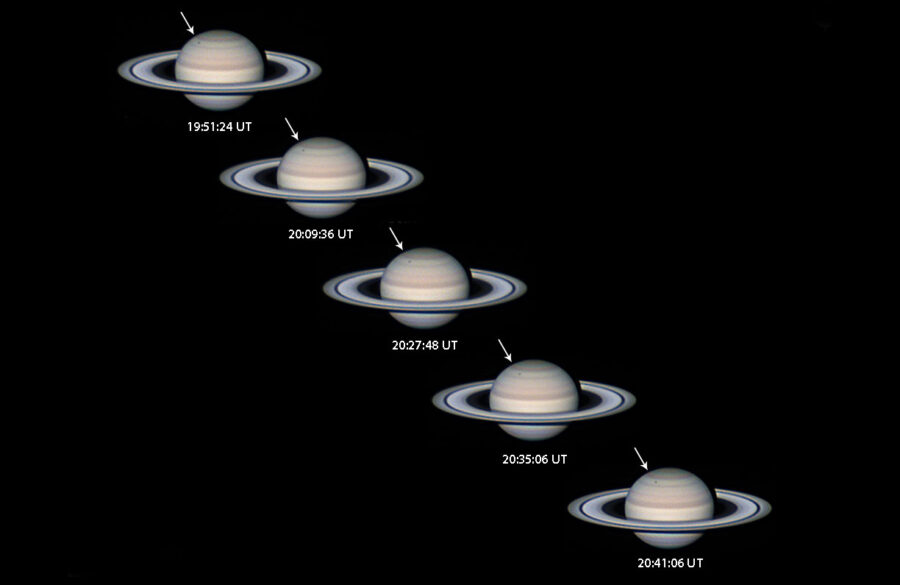
Darryl Milika and Pat Nicholas
Saturn's the place to be this month. A little more than a week after its largest moon Titan occulted a star on July 9th, we're up for a rare transit of the planet's third-largest moon Iapetus. The event lasts about 19 hours — from approximately 21:00 – 16:00 UT July 17–18 (5 p.m. Sunday evening July 17th to 11 a.m. Monday morning July 18th EDT) — which means many geographic locations will see at least part of the event, including the entire U.S. from Maine to Hawaii.
No mincing of words here — it will be visually challenging because the moon spans a mere 0.23″ and will require at least a 10-inch telescope and excellent atmospheric seeing to observe. I suspect it will also test the mettle of planetary imagers, though prove easier to capture than by eye alone.
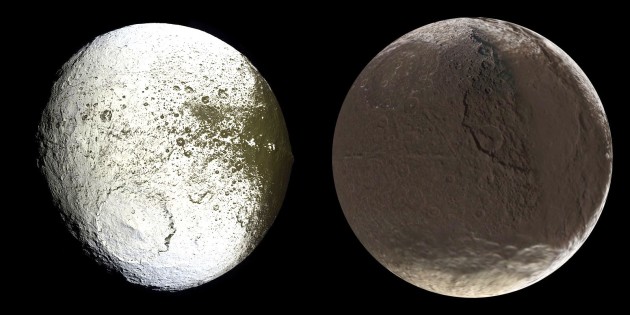
NASA / JPL / Space Science Institute
This is actually Iapetus's second transit this year. The first occurred on April 29–30 but was not visible in the Americas. The next will happen on December 23 but only for observers in the eastern hemisphere. After that we have to wait until the 2037 transit, which is also problematic because it takes place close to solar conjunction. The next "easy" shot at seeing this uncommon event won't be until 2052! That makes this opportunity one you don't want to miss.
Saunter at Saturn
On July 17th at about 21:12 UT, Iapetus makes first "contact" with the northeastern edge of the outer A ring just 4.6″ from Saturn's globe. Keep in mind that despite appearances, especially when crossing the rings, Iapetus will pass in front of the planet the entire time. The yin-yang moon may prove difficult to spot near the bright rings because we happen to be facing the side coated in coal-black dust, dimming the target from magnitude 10 to 11.2. In a moment, we'll see how this also has advantages.
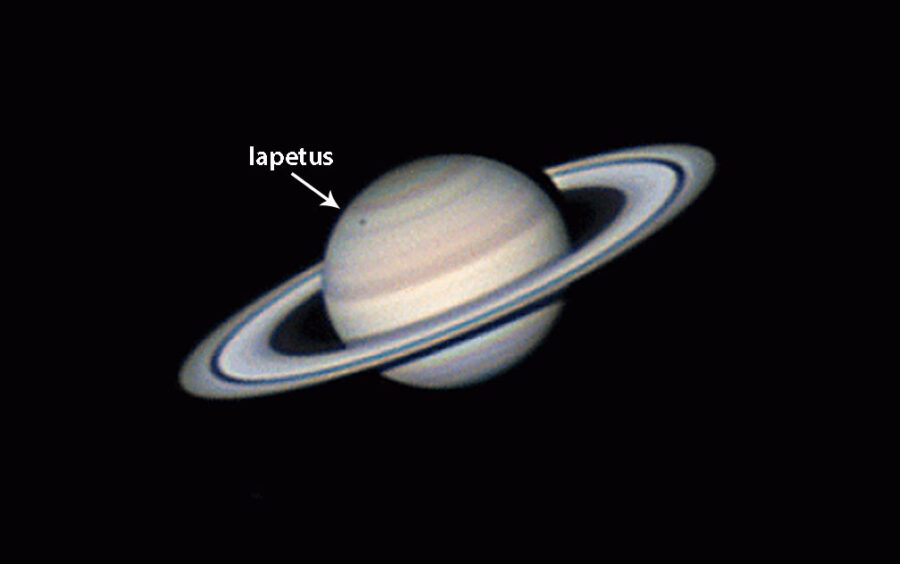
Darryl Milika and Pat Nicholas
At around 22:38 UT, Iapetus may pop more clearly into view for about 20 minutes as it crosses in front of the dark Cassini Division. A little more than hour later at 23:48 UT, it nestles into Saturn's limb, and the transit officially begins. Central meridian passage occurs at 4:42 UT July 18th (12:42 a.m. EDT), with Saturn well-placed for East Coast observers at ~25° altitude and a reasonable 15° for the Midwest. Atmospheric seeing is critical to a positive outcome, so the higher the planet the better.
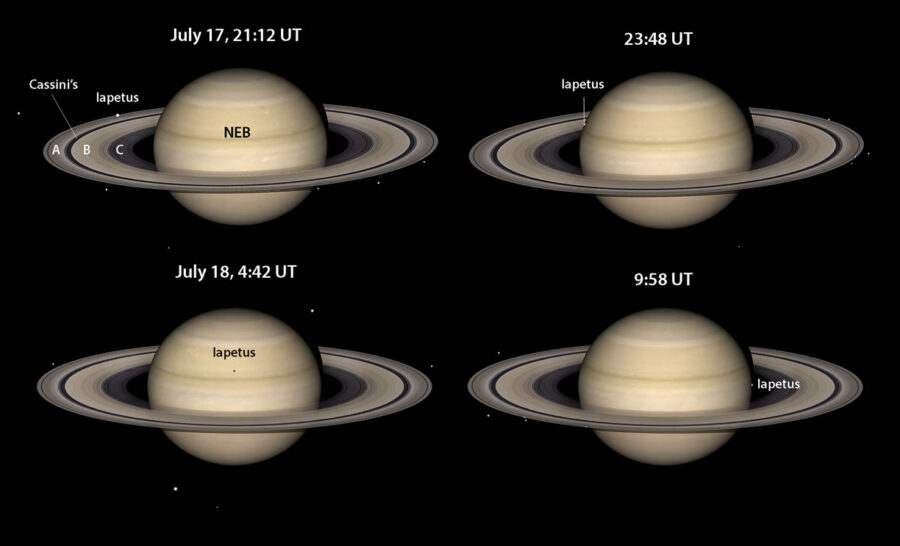
Stellarium
For more than 10 hours the moon will track west across the planet's lighter North Tropical Zone (NTrZ) just north of the prominent North Equatorial Belt (NEB). This is where Iapetus's dark hemisphere becomes a big plus — hovering above pale clouds, it will stand out in splendid contrast. But there's a caveat: Its orbit is inclined 15.5° to Saturn's equator. As the transit proceeds, the moon will gradually cross the dark NEB, temporarily becoming more difficult to see until it's "in the clear" again in the Equatorial Zone south of the belt. It's difficult to tell exactly when and how long it will spend over the NEB by simulations alone, but I estimate it will clear the belt by around 9:00 UT or roughly an hour before the transit ends at 9:58 UT.

WinJUPOS
For observers in the eastern half of the U.S., twilight and sunrise will interfere before the transit ends, but farther west the moon marches on, passing over the inner C ring (starting ~11:05 UT), the bright B ring (mid-point at around 13:25 UT), and revisiting the Cassini Division at 14:36 UT before exiting the ring plane at around 16:02 UT.
| Start of A-ring ingress | July 17, 21:12 UT (5:12 p.m. EDT) |
| Centered over Cassini's Division | 22:38 |
| Transit begins | 23:48 |
| Central meridian passage | July 18, 4:42 UT (12:42 a.m. EDT) |
| Transit ends | 9:58 |
| Start of C-ring ingress | 11:05 |
| Mid-point B-ring | 13:25 |
| Centered over Cassini's Division | 14:36 |
| End of A-ring egress | 16:02 |
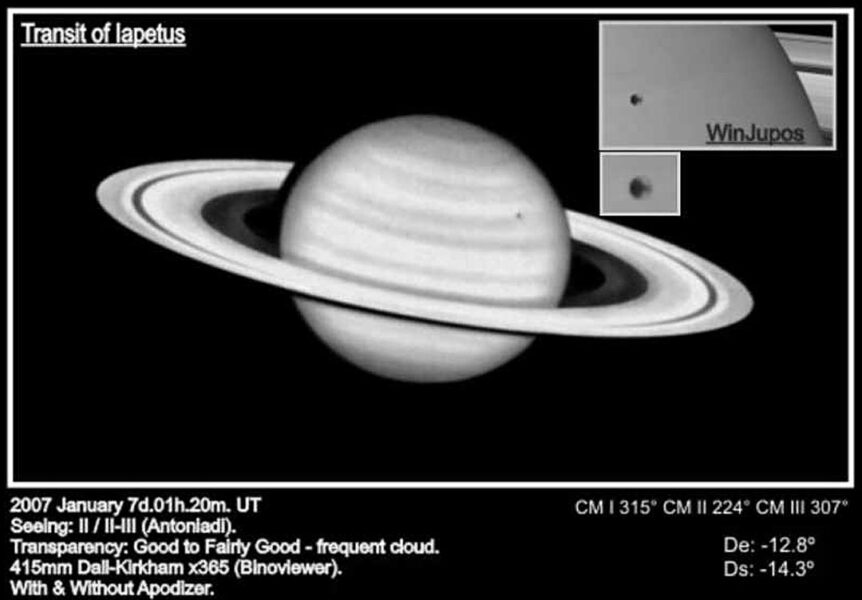
David Gray
Several British Astronomical Association members visually observed the Iapetus transit on January 6–7, 2007. Two observers used 16-inch telescopes and clearly recorded the moon, while another suspected Iapetus at the correct position in his 10-inch. This gives me hope that with good seeing, high magnification, and careful, relaxed observation I might even see it myself. Of course, we'd love to hear if you do.
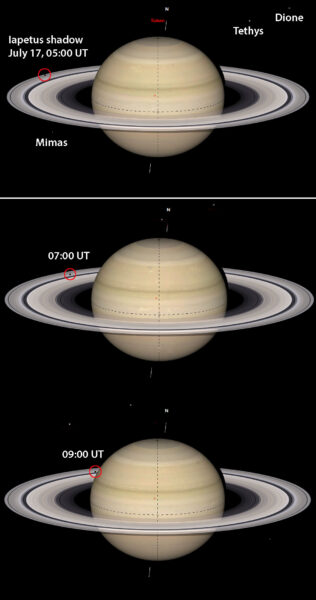
WinJUPOS
Bonus shadow transit
The morning before the transit there will also be a shadow transit of Iapetus. I ran a simulation using the free and excellent WinJUPOS program and found that the moon will cast its shadow on the A ring from about 5:00–9:00 UT on July 17th (1–5 a.m. EDT). The shadow then shifts to the front of the planet, but keeps close to the ring plane for several hours until emerging into view again south of the plane from 14:00–17:50 UT. I have no idea if this will even be visible or photographable. After a search I only turned up this Cassini image. Maybe you'll be one of the first to see or picture it.
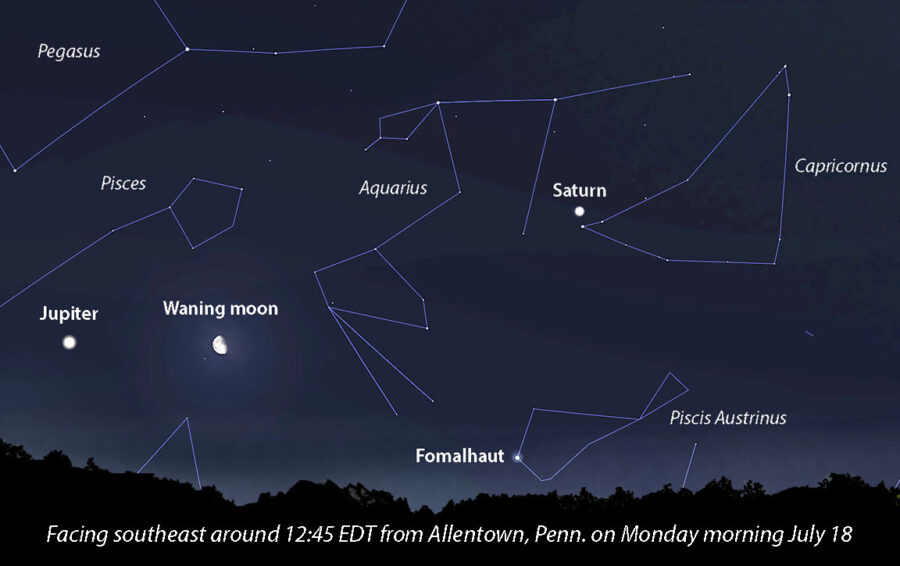
Stellarium
If you're hanging your head because you don't have access to a larger telescope, your time will come. Saturn's largest moon Titan, which orbits in the equatorial plane like the rings, will cast a much more prominent shadow on the globe during the next ring plane crossing (edgewise presentation) starting in March 2025. Even a 4- to 6-inch scope in good conditions will reveal the amazing sight. Good luck this weekend!
 6
6









Comments
Anthony Barreiro
July 18, 2022 at 4:26 pm
Paul Abel sketched the transit as seen through a 208 mm Dall Kirkham telescope in Leicester UK.
https://www.cloudynights.com/topic/832517-the-transit-of-iapetus/
You must be logged in to post a comment.
Bob KingPost Author
July 18, 2022 at 7:53 pm
Thanks for posting, Anthony. Much appreciated. You wrote "208 mm" but suspect that was a typo — I see that he recorded it with a 508 mm (20-inch) scope.
I had my 15-inch on Saturn for more than an hour, but the seeing simply didn't improve to the point where I could definitively say I saw Iapetus. I don't think I've ever stared at anything that long while also continuously fighting hordes of mosquitos! Still, I don't regret the time. There's something about concentration and pushing limits I continue to find rewarding.
You must be logged in to post a comment.
Anthony Barreiro
July 18, 2022 at 8:20 pm
Thank you Bob. Sorry about the typo. Yes, 508 mm.
I hope the mosquitos didn't feast too heartily while you were staring at Saturn.
You must be logged in to post a comment.
Bob KingPost Author
July 18, 2022 at 10:46 pm
Anthony,
After a while I grew so tired of reapplying bug dope I just started slapping my head when they got close. All went fine. What a joy at the end of the night to drive 60 mph all the way home with the windows rolled down. I just received a nice report and photo from an observer who succeeded in getting a photo of Iapetus in his 10-inch Dob.
You must be logged in to post a comment.
bob kelly
July 25, 2022 at 12:46 pm
"It's tiny. It's challenging."
It was cloudy.
bob k
You must be logged in to post a comment.
Bob KingPost Author
July 25, 2022 at 10:55 pm
Hi Bob,
Clouds — the greatest challenge of them all 😉
You must be logged in to post a comment.
You must be logged in to post a comment.